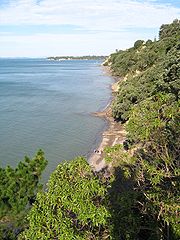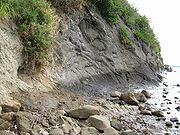
Achilles Point
Encyclopedia

Auckland
The Auckland metropolitan area , in the North Island of New Zealand, is the largest and most populous urban area in the country with residents, percent of the country's population. Auckland also has the largest Polynesian population of any city in the world...
, New Zealand
New Zealand
New Zealand is an island country in the south-western Pacific Ocean comprising two main landmasses and numerous smaller islands. The country is situated some east of Australia across the Tasman Sea, and roughly south of the Pacific island nations of New Caledonia, Fiji, and Tonga...
. The name 'Te Pane o Horoiwi' can also sometimes refer to the whole headland between St Heliers and Tamaki River estuary. Achilles Point is named after a ship called HMNZS Achilles (70)
HMNZS Achilles (70)
HMNZS Achilles was a Leander class light cruiser which served with the Royal New Zealand Navy in World War II. She became famous for her part in the Battle of the River Plate, alongside HMS Ajax and HMS Exeter....
which defeated the German pocket battleship Admiral Graf Spee in 1939. The headland, from the point round to the Tamaki heads, was previously known as Te Pane o Horoiwi, named after Horoiwi who arrived in New Zealand on the Tainui
Tainui
Tainui is a tribal waka confederation of New Zealand Māori iwi. The Tainui confederation comprises four principal related Māori iwi of the central North Island of New Zealand: Hauraki, Ngāti Maniapoto, Ngāti Raukawa and Waikato...
canoe (waka).

Glover Park is an ancient volcanic crater
Volcanic crater
A volcanic crater is a circular depression in the ground caused by volcanic activity. It is typically a basin, circular in form within which occurs a vent from which magma erupts as gases, lava, and ejecta. A crater can be of large dimensions, and sometimes of great depth...
which erupted more than 50,000 years ago. The volcanic tuff ring crater is also known in Māori language
Maori language
Māori or te reo Māori , commonly te reo , is the language of the indigenous population of New Zealand, the Māori. It has the status of an official language in New Zealand...
as Whakahumu or geologically as the 'St Heliers explosion crater'. It is found in the center of the headland between West Tamaki
Tamaki
Tamaki may refer to:Places:*Afghanistan**Tamaki, Afghanistan*Japan**Tamaki, Mie*New Zealand**Tamaki, New Zealand, a suburb of Auckland**Tāmaki , in Auckland**East Tamaki, a suburb of Auckland**Tamaki River, in Auckland...
Head and the eastern end of St Heliers Bay beach. It was filled in during the 1950s to form a public sports field. Before that it formed a seasonal shallow lake or swamp.

There is an old concrete water tower built on the tuff ring formed around the edge of the crater opposite the seaward side.
Geology

Scoria
Scoria is a volcanic rock containing many holes or vesicles. It is most generally dark in color , and basaltic or andesitic in composition. Scoria is relatively low in mass as a result of its numerous macroscopic ellipsoidal vesicles, but in contrast to pumice, all scoria has a specific gravity...
, andesite
Andesite
Andesite is an extrusive igneous, volcanic rock, of intermediate composition, with aphanitic to porphyritic texture. In a general sense, it is the intermediate type between basalt and dacite. The mineral assemblage is typically dominated by plagioclase plus pyroxene and/or hornblende. Magnetite,...
, and pumice
Pumice
Pumice is a textural term for a volcanic rock that is a solidified frothy lava typically created when super-heated, highly pressurized rock is violently ejected from a volcano. It can be formed when lava and water are mixed. This unusual formation is due to the simultaneous actions of rapid...
.
At low tide there is an interesting walk from Ladies Bay along the base of the cliffs to St Helier's Bay. The rocky shoreline overlooks the Waitamata Harbour which itself occupies a drowned valley system cut in marine sediments of Miocene
Miocene
The Miocene is a geological epoch of the Neogene Period and extends from about . The Miocene was named by Sir Charles Lyell. Its name comes from the Greek words and and means "less recent" because it has 18% fewer modern sea invertebrates than the Pliocene. The Miocene follows the Oligocene...
Age (15–25 million years ago). Generally, around Auckland these soft Miocene sediments are alternating Waitamata series sandstone
Sandstone
Sandstone is a sedimentary rock composed mainly of sand-sized minerals or rock grains.Most sandstone is composed of quartz and/or feldspar because these are the most common minerals in the Earth's crust. Like sand, sandstone may be any colour, but the most common colours are tan, brown, yellow,...
and mudstone
Mudstone
Mudstone is a fine grained sedimentary rock whose original constituents were clays or muds. Grain size is up to 0.0625 mm with individual grains too small to be distinguished without a microscope. With increased pressure over time the platey clay minerals may become aligned, with the...
with more massive beds of sandstone sometimes with minor occurrences of limestone .
The concretions that can be easily seen, are formed by the action of ground water with dissolved minerals (mainly calcium carbonate
Calcium carbonate
Calcium carbonate is a chemical compound with the formula CaCO3. It is a common substance found in rocks in all parts of the world, and is the main component of shells of marine organisms, snails, coal balls, pearls, and eggshells. Calcium carbonate is the active ingredient in agricultural lime,...
of which limestone
Limestone
Limestone is a sedimentary rock composed largely of the minerals calcite and aragonite, which are different crystal forms of calcium carbonate . Many limestones are composed from skeletal fragments of marine organisms such as coral or foraminifera....
is made) percolating through the layers. Calcium carbonate is an important component of concrete and fills in the pore spaces between grains of sediment thereby cementing the grains together and making them more durable against erosion
Erosion
Erosion is when materials are removed from the surface and changed into something else. It only works by hydraulic actions and transport of solids in the natural environment, and leads to the deposition of these materials elsewhere...
.
External links
- Archaeology and History of St Heliers, Auckland.
- Geology of the headland
- Point to point walkway ARC - St Heliers to Churchill park through the crater at Glover Park
- Explanation of concretions
- Point to Point walkway. The full point to point walk is approximately 7.5km long, starting at the popular St Heliers Bay and finishing at Point England. Allow three to four hours.

